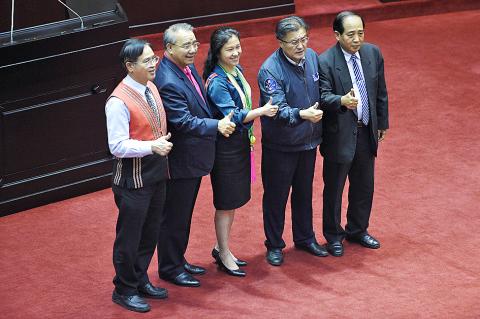The Aboriginal Language Development Act (原住民族語言發展法) yesterday passed its third reading at the Legislative Yuan, granting official status to Aboriginal languages.
Local governments, Aboriginal regions and non-Aboriginal areas with more than 1,500 Aborigines should establish an office tasked with the promotion of local languages, the regulations say.
The act stipulates that the central government should help establish organizations to promote Aboriginal languages, as well as chair meetings with each of the recognized communities to ascertain what new words should be incorporated, assist in compiling Aboriginal dictionaries and establish online linguistic archives.

Photo: Chen Chih-chu, Taipei Times
The primary goal of the policy is to encourage the learning of languages that are nearly extinct, regularly hold polls to gauge language learning, hold free exams and award Aboriginal language certificates, lawmakers said.
Within three years of the act’s promulgation, Aborigines taking civil servants’ special exams and those studying abroad on public funds would be expected to have an Aboriginal language certificate, the act says.
When hiring staff in accordance with the Indigenous Peoples Employment Rights Protection Act (原住民族工作權保障法), the government and public schools should prioritize people who speak Aboriginal languages, it says.
Government institutions, public schools and corporate entities in Aboriginal areas would be required to prepare official documents in commonly used languages of the area, while all public transportation in Aboriginal areas would be required to use the languages in announcements, the act says.
When conducting official business, standing trial in court or during any other judicial procedure, Aborigines would be allowed to use their own language to express themselves, and in such cases the government would have to hire an interpreter, it says.
All schools should follow the curriculum as set out according to the 12-year national basic education and provide Aboriginal language courses, it says, adding that such courses should be taught in Aboriginal languages.
Local education bureaus and departments should launch programs to train full-time Aboriginal-language teachers.
The government should set aside funds to promote Aboriginal-language publications, while state-run media should produce programs and language courses, the proposed rules say.
Air time for Aboriginal-language content in government-owned or government-invested media should not be less than 50 percent, it says.
The government officially recognizes 16 Aboriginal groups: Amis, Tao, Paiwan, Bunun, Puyuma, Thao, Atayal, Saisiyat, Tsou, Rukai, Kavalan, Sakizaya, Sediq, Hla’alua, Kanakanavu and Truku.

Taiwan is to commence mass production of the Tien Kung (天弓, “Sky Bow”) III, IV and V missiles by the second quarter of this year if the legislature approves the government’s NT$1.25 trillion (US$39.78 billion) special defense budget, an official said yesterday. Commenting on condition of anonymity, a defense official with knowledge of the matter said that the advanced systems are expected to provide crucial capabilities against ballistic and cruise missiles for the proposed “T-Dome,” an advanced, multi-layered air defense network. The Tien Kung III is an air defense missile with a maximum interception altitude of 35km. The Tien Kung IV and V

The disruption of 941 flights in and out of Taiwan due to China’s large-scale military exercises was no accident, but rather the result of a “quasi-blockade” used to simulate creating the air and sea routes needed for an amphibious landing, a military expert said. The disruptions occurred on Tuesday and lasted about 10 hours as China conducted live-fire drills in the Taiwan Strait. The Civil Aviation Administration (CAA) said the exercises affected 857 international flights and 84 domestic flights, affecting more than 100,000 travelers. Su Tzu-yun (蘇紫雲), a research fellow at the government-sponsored Institute for National Defense and Security Research, said the air

A strong continental cold air mass is to bring pollutants to Taiwan from tomorrow, the Ministry of Environment said today, as it issued an “orange” air quality alert for most of the country. All of Taiwan except for Hualien and Taitung counties is to be under an “orange” air quality alert tomorrow, indicating air quality that is unhealthy for sensitive groups. In China, areas from Shandong to Shanghai have been enveloped in haze since Saturday, the ministry said in a news release. Yesterday, hourly concentrations of PM2.5 in these areas ranged from 65 to 160 micrograms per cubic meter (mg/m³), and pollutants were

Taiwan’s armed forces have established response protocols for a wide range of sudden contingencies, including the “Wan Chun Plan” to protect the head of state, the Ministry of Defense (MND) said today. After US President Donald Trump on Saturday launched a series of airstrikes in Venezuela and kidnapped Venezuelan President Nicolas Maduro, concerns have been raised as to whether China would launch a similar “decapitation strike” on Taiwan. The armed forces regularly coordinate with relevant agencies and practice drills to ensure preparedness for a wide range of scenarios, Vice Minister of National Defense Hsu Szu-chien (徐斯儉) told reporters before a